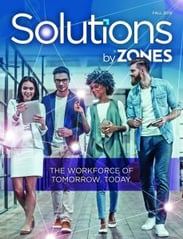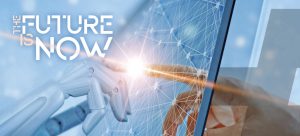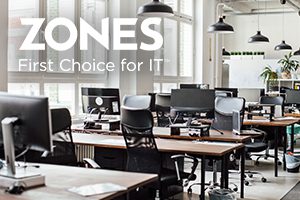Unburden your IT team with the help of a capable service desk
Around the business world today, “workplace modernization” is a buzzword you hear a lot. Many corporate IT leaders are talking about the importance...

To gain some perspective on the evolving needs of today’s digital workforce, our editor met with Michael Martin, Chief Technology Officer of Zones nfrastructure®, the Services Company of Zones™. Here’s what they discussed…
Editor: As you know, the workforce today is nothing like it used to be 10 or even five years ago. The internet, wireless connectivity, data accessibility, and all sorts of other technologies have changed everything right in front of our eyes.
All of that impacts how companies do business – and what the workforce expects from them. These days, it isn’t unusual to see employees turn down positions because of dated or inefficient technology. What’s your take on this change?
Martin: It’s fascinating. New generations – folks born in the mid-1990s and early 2000s – are entering the workforce with an entirely different set of expectations. When getting a job in the past, employers would often dictate the types of technology you’d use. The company would issue standard devices, tell you which apps you’d need, direct you to your static work station, and so on.
The folks that are entering the workforce now have an entirely different frame of reference. They’ve grown up with commercial technology that they’ve selected themselves. They know which tools they prefer, and they expect the workplace to accommodate those preferences so that they can work most effectively.
The user experience will be the primary focus over the next five to 10 years. Users want a terrific technology experience whether they are working in an office, at home, or on the road. All the technologies supporting that experience are important. End user devices are obviously a central component, but so is the network, the mode of authentication, the tools used to collaborate, and the quality of their productivity and business applications. Given all of that, I think we’re going to be very focused on creating great experiences for the workers of tomorrow.
Editor: It sounds like it. This digital-born generation is really effecting that sort of change. It’s no longer, “Here’s what you have to adhere to.” It’s become, “How can we adapt to what you already know?”
Martin: Precisely.
Editor: A lot of companies are still adjusting to this digital transformation. What steps can they take to transition more effectively?
Martin: Sometimes, people think that digital transformation is a matter of devices or technology, but it’s so much more than that.
The companies on the right track are the ones looking at the workplace holistically – all the way back to the fundamental organization of teams and how that structure supports the kind of workplace experience they want to offer. In the 90s, for example, IT organizations were very siloed. Teams were organized around different kinds of technologies – desktop groups, mobile groups, Exchange groups focused on email, phone system groups, and so on.
Now, we’re seeing smart companies shift that organization around. Rather than have a group for every kind of device, they’re forming, for instance, an endpoint team – a group focused on supporting all the devices employees are using. They’re forming cloud office teams to support commonly used software-as-a-service (SaaS) productivity applications. They’re rethinking their approach.
The next step is moving from endpoint and application teams into a single team focused on the entire digital workplace experience. That way, workers won’t get bounced around from self-servicing support groups based on whether a problem is device- or app-related. The team will support the outcome rather than a single technology component. A lot of companies are starting to walk that path, and they’re looking for technology partners that can help guide them on that journey.
Editor: That’s a fresh perspective – building teams around what you’re accomplishing, not how you’re accomplishing it. It seems like a much smarter focus.
Martin: Absolutely. Today’s workers don’t want to be told, “Oh, that’s some other department’s problem.” When you’re trying to get something important done, you want to be able to reach a support group that can help you make it work regardless of application or device.
Editor: Whatever method is required, right? Earlier, you mentioned that companies are looking for partners to help them make this digital transition. That’s actually a great segue into my next question: What makes Zones qualified to help partners accomplish all of this?
Martin: The first thing I’ll mention is the way we’ve calibrated our service capabilities.
At Zones, we have four main areas of focus: Workplace Modernization, Network Optimization, Data Center Transformation, and Security Fortification. And talking about one often involves the other three. When discussing Workplace Modernization, for example, you might need to discuss how your network supports those workplace requirements, how your data center or the cloud supports the back-end applications you’re using, or how to secure all of those devices and applications.
Together, these Solution Environments cover the full spectrum of challenges businesses face in their digital transformations – that’s why we’ve organized our go-to-market strategy around them.
With Workplace Modernization, we focus on three specific areas customers need to address in order to provide their employees a more modern office experience. The principle behind this relates to what I talked about before. Instead of looking at end-user devices as one silo and their applications as another, we’ve grouped all of that together in a pillar called End-User Compute & Productivity. This includes laptops, tablets, cell phones, productivity application suites like Office 365, mobile device management, security, and more.
Collaboration is our second pillar within Workplace Modernization. In the modern workplace, employees want to be able to collaborate with teammates wherever they are. Collaboration technology has come a long way to support this type of open synchronization across teams – even when the teams aren’t colocated. Things like video conferencing and intelligent whiteboards (“smartboards” such as Microsoft Surface Hub or Cisco’s WebEx Board) let you collaborate with video, share whiteboarding, share files, and work together across locations in real time. We’re also starting to see a lot more voice interface technologies enter the office environment. For example, an Amazon Echo might now be integrated with a conference room, enabling a worker to simply enter the room and say, “Alexa, start my meeting.” Very interesting stuff.
Last but not least, our third Workplace Modernization pillar is Store & Branch Modernization – the solutions we use to help optimize the customer experience. Large enterprises often have strong IT staff to support their headquarters, but many of them struggle to reach the requirements that exist across a widely distributed edge. This need is further magnified in industries supporting retail locations that drive the primary interaction with customers.
The retail and banking industries, for instance, are changing rapidly – and a physical location that integrates technology into the customer experience is becoming a strategic necessity. Integrating new technologies across hundreds of locations, requiring thousands or even tens of thousands of devices, requires a very specialized set of resources, processes, and tools. As a result, it often makes sense to leverage an experienced delivery partner to help fulfill on these engagements.
I think our deep focus on all of the aspects that go into Workplace Modernization is what sets Zones apart from other providers. We’ve done a lot of homework around the key challenges that our customers are facing.
Editor: It sounds like it. When we started this conversation, we both mentioned how fast things have changed in the past few years. You touched on a couple of these points already, but what other developments do you see headed to the digital workplace in the near future? Any foresight into where things might head in the next decade?
Martin: Great question. First, I’m positive that a few major trends will continue. I talked a bit about voice as a user interface earlier, and I definitely expect that to keep growing in prominence. We also touched on the increased importance of wireless networks – wireless has quickly become the primary network in most of our customers’ environments. Another existing trend that will continue to be relevant is the shift from desktop to mobile. We’re all doing more and more with our mobile devices these days, and we expect that to translate into the office as well.
All that said, it’s impossible to foresee exactly how technology will evolve over the next 10 years. Given that, I actually think it’s more useful to try to anticipate the things that won’t change. Focusing on the things that will endure puts us in a great position to accommodate and embrace whatever the future holds. For instance, I’m quite confident that an end user “device” will continue to be an important technology into the future.
No matter what types of new devices are invented – whether they’re handheld or wearable or potentially even implanted – we’ll always have some sort of device to support at the edge. And those devices will need a very robust network to communicate with back-end applications. And those backend applications are going to run in a data center somewhere, whether it’s on premises or in a public cloud. And that entire interaction is going to need security. That’s why we’ve organized our services around the four Solution Environments I referenced earlier. I think those pillars will endure throughout all the technology developments we’ll see in the next few years.
Editor: That makes a lot of sense. Your strategy addresses the challenges of today, but it plans for the future as well.
Martin: Exactly. And no matter what devices or technologies arise, they will progress through a lifecycle of purchasing, configuration, delivery, integration, support, and ultimately disposition. We’re building our services to support customers throughout that entire lifecycle. And whatever types of technologies are involved, whether they exist in the workplace, on the network, in the data center, or in the realm of security, that set of services will absolutely remain relevant into the next decade.
Editor: Mike, I really appreciate you taking the time for this interview. It’s always a pleasure talking, especially about a topic that’s so relevant. After all, we’re players in the workforce ourselves.
Martin: My pleasure. And yes, for sure – as members of the workplace, we’re all very interested in getting this one right.
Editor: Well put. I look forward to seeing what the future holds – and where Zones can help take it.
 This article originally appeared in the Fall 2018 edition of Solutions by Zones magazine.
This article originally appeared in the Fall 2018 edition of Solutions by Zones magazine.

Around the business world today, “workplace modernization” is a buzzword you hear a lot. Many corporate IT leaders are talking about the importance...

Just a few years ago, the thought of asking a robot to dim the lights and start playing a particular album would have seemed impossibly futuristic....

It’s hardly the most glamorous aspect of workplace modernization, but it’s nonetheless one that needs to be addressed – there are far too many...